

Local businesses have secure access to climate resilient markets, technologies, financing, and transport channels
Objectives to achieve goal:
Secure employment in existing and emerging markets
As new industries and technologies emerge over the next decade in response to a low carbon future, the transition will impact those currently in the workforce and young people looking to enter.
Having the skills and training to secure jobs for the future is critical. Employers, governments, and educational institutions will need to plan in a considered way rather than reacting to market failures, which can negatively impact a generation of workers. People in casualised work such as young people and workers from migrant communities are particularly vulnerable in the workforce especially in the extreme weather and emergency events.

Priority Actions
Create joint training collaborations between business and education providers to respond to the diversification of employment patterns and demand for new skills
Create targeted programs that support long-term local employment opportunities for those most disproportionally impacted by climate change
Develop projects to increase Aboriginal employment opportunities and outcomes in new and emerging job markets
Support business adaption to low emission and circular economy markets and supply chains
Many businesses in the region have complex networks of suppliers and customers. As a result, the increasing global action to reduce emission can create transitional and adoption risk.
The interconnected risks from a global marketplace mean we must build resilience and secure more long-term sustainable markets.
A clear signal from all government levels is required to ensure that businesses invest and build a local innovation culture on climate impacts and transition to a low carbon future.


Priority Actions
Establish support services for business to access alternative markets when existing ones are or may be disrupted by the impacts of a changing climate
Deliver programs that assist business access to low emission opportunities. For example alternative fuels (including renewable energy farms, hydrogen and materials), recycling and a circular economy
Support sustainable and secure financing for climate adaptation
Businesses need to have access to finances to support their effort to avoid, minimise and or offset the impact of climate change on their business.
There are limited financial mechanisms for business. Most opportunities are usually complex grants, high-interest loans or unfair equity investing.
It can also be challenging to find out which of the many potential funding sources are relevant for a specific business adaptation project or activity.


Priority Actions
Establish local financial and insurance policy support services for non-employee, small and medium businesses
Create equitable funding or financing opportunities for businesses to uptake technology or building upgrades that assist with protecting premises/assets from extreme events
Support business operations and processes during and recovering from direct extreme weather and climate impacts
Extreme weather events are becoming more widespread, increasing the risk of disruption to business operations and processes.
Emergency response strategies for supporting a range of business during severe weather conditions need to be addressed appropriately, as does the support to businesses and employers recovering from operational shutdowns and associated work loss.


Priority Actions
Establish support services to assist businesses to maintain operational continuity during extreme weather of other climate related commercial disruptions
Develop mechanisms to allow businesses to collaborate with government agencies and industry partners to identify opportunities that lead to faster restoration and recovery works and services critical to their business operations
Support business operations during indirect extreme weather and climate impacts
Extreme weather events can cause disruption to utilities and supply chains.
Building resilience into our utility networks locally will be critical. It will require business and governments to collaborate on innovative solutions for advanced protection and recovery systems of all our utility services.
Supply chain disruption and discontinuity from climate impacts or extreme weather are also concerning. Disruptions can mean inconsistent or inadequate product quality, unpredictable delivery times, and substantial, unanticipated additional costs to businesses.

Priority Actions
Establish a local business network to work with government, utility networks and industry to better coordinate Distributed Energy Resources regionally to strengthen and support the utility network resilience
Develop regional planning assessment to identify parts of the transport system at high risk, vulnerable, or face the most significant exposure of being impacted by anticipated climate change. Plan to address any insurance gaps or inform the prioritisation of protecting those transport assets, infrastructure and services
We acknowledge and respect Victorian Traditional Owners as the original custodians of Victoria’s land and waters, their unique ability to care for Country and deep spiritual connection to it. We honour Elders past and present whose knowledge and wisdom has ensured the continuation of culture and traditional practices. We are committed to enabling self-determination for all Aboriginal people and aim to work closely with the Aboriginal community to drive action and improve outcomes especially in the context of a changing climate.